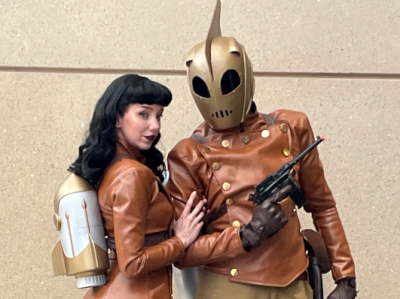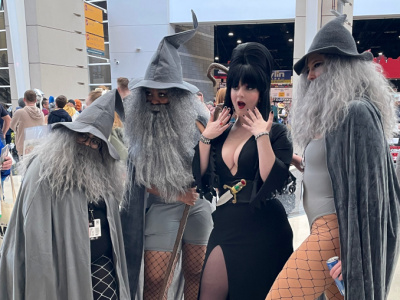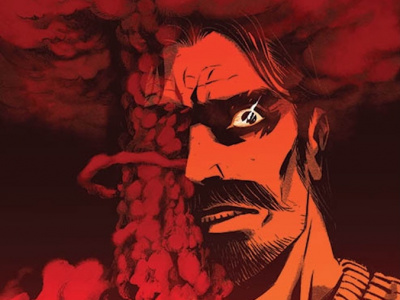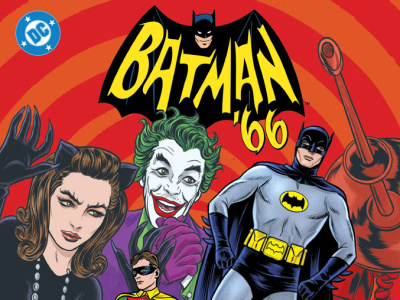ICv2 recently spoke with DC President Paul Levitz. In this second part of our two-part interview, we talk about the success of Sandman: Endless Nights, DC movies and TV shows, kids comics, creator exclusives, and a possible foray into manga.
Sandman: Endless Nights came out last week and obviously you guys were talking about the fact that it's been ordered very well. As of today, Monday, after the first weekend, have you gotten any early indications from any channel on how it's selling?
We have a bunch of indications. It's much more difficult in the complicated channels that we're in now to be able to point clearly and say 'this is exactly what's happening here.' But when we set the print order for the book (it was a fairly complicated print job, so that was probably about two months, ten weeks prior to publication), we set it for about a 50 percent overprint. We have blown that out pretty much already, so we're back binding up another 20,000 copies that we had interiors prepared to go either hard or soft depending on the market opportunity. We have unfilled orders on the book side at the moment (because we want to make sure we've filled all of our retail orders before we start feeding any distributor channels), and a lot of great anecdotal information.
From comic stores, or bookstores, or both.
Both. With the book chains you have the advantage that they have methodology for measuring checkout on individual titles very quickly. So the large guys there are very happy and are coming back with some incremental orders.
That's what I was wondering: because it was ordered in so heavy by the book trade, what was the sell-through like in the chains?
Everybody seems happy and asking for more.
I think the New York Times put out the number 100,000--that was the print run on Endless Nights?
That was the first printing. Or 'binding' is probably a fairer way of putting it.
I think Bob said something about this being the biggest DC book ever (see 'Interview With DC's Bob Wayne, Part II'). I was trying to think back to the early '90s: Arkham Asylum? How many was that?
Arkham would have beaten that number, but probably will not beat what we've got with the second binding of the first printing.
Turning to some DC licensing questions: after a long drought, a long break, a couple of movies featuring DC characters are in production. Can you give us a recap of DC's movie pipeline?
Well, we don't announce the stuff that's in development. The production side or the near production side we've got both Cat Woman and Constantine starting filming this month, which is very cool. As you say, it's been a few years. And it's our expectation that Batman will begin filming in February. Anything past that is a little bit more speculative, so we'll just count them as the stack of scripts sitting on the desk.
And Constantine and Catwoman; are those going to be out next year?
Yeah, both should be out next summer.
And then on television: what have you got on TV that's going to be on this year in the fall season?
We have a record six shows in production right now. We have Justice League, which is still running in production because they picked up another 26 episodes of that for Cartoon Network a while ago. Teen Titans is in production, we're still on the first 26 there; Static Shock is on its fourth season, or fourth order. All three of those are coming out as part of existing animation projects.
We have a new Batman animated program in the early stages of production, which is going to be a lot of fun, I think. On the live side, we have Mad TV, which feels like it's in its four millionth season, I think eighth or ninth or tenth or something frightening like that. And Smallville, which gives us six shows on air -- or rather six shows in production -- which gives us a new record. And we have a couple in development for pilots for the new season.
That would be next fall?
Yeah, fall '04.
Recently it's been pointed out that Wildstorm was advertising for a manga editor, and in the job description it said 'personally edits up to ten monthly import editions' (see 'DC-Wildstorm Hiring Manga Editor'). Can you talk a little bit about DC's plans in the manga world?
It's always been my desire for us to be publishing comic books across the widest possible range of things that people are interested in. Very clearly, manga's become a significant portion of the reading habits for comics, defined broadly, in America, so I'd be really sad if we weren't able come up with a way to be a significant force in that business. There are a number of ways we may enter it; we're working on them now, but I would hope that by about a year from now we'll start being in that business in a meaningful way one way or another.
Over the last year, the return of Disney to the comics market has sparked a lot of discussion about kid's comics, at least on our site, and I think there was discussion about it other places as well. Recently we talked to Bob about setting print runs, and he mentioned as sort of an aside that for DC's kids books, he was actually able to cut extras, because reorder activity was very weak, and was able to use those resources to increase overprints on books that were more appealing to the direct market. The question is: DC's got some pretty good properties. Do you think it's an issue of format or distribution or editorial material why those properties don't sell better?
I think it's probably all three. We've got a significant initiative in the bookstores in kids digest formats starting this fall. I think we've already shipped the first two Power Puff titles, and we've solicited Scooby Doo and Justice League Adventures digests that will come out later on this fall. We've had some good adoptions from some of the school book fair special market distribution there as well, which hopefully helps reach kids. I would hope those formats would be useful in the comic stores as well. I think we get some decent numbers on some of the titles: Scooby Doo, between newsstand, subscription, and comic shop sales, has typically been a reasonably profitable title. Maybe the only one I'm aware of on a long-term, sustained basis in the kids space in our business.
You mentioned 'kids digest format.' Is that, what, $9.95?
That's a very good question. I've got one sitting on the shelf somewhere. Here we go: $6.95 and 112 pages, to answer your next question.
Where do they put them in the bookstores?
God willing, in the kids section.
And at that price point, that would seem to have some mass merchant potential. Have you gotten any bites there?
It's hard with the mass merchants, I mean they may be buying some through Ingram or some other portion of the book distribution system, but it's hard when you only have a couple of titles. Once we've got a few out there, if the format works, presumably other people will come in as well with their kid-appropriate material and we'll see if there's a natural home for the mass merchants.
DC's recently announced some creator exclusivity agreement signings. I'm just wondering if you see any trends there with a higher percentage of talent being under contract, or is it pretty stable from your perspective?
I haven't run any numbers on what percentage it's been since I was doing that hands on almost 25 years ago. I think you've got a couple of goals that have historically been driving that phenomenon. On the artist side, if an artist is making a significant contribution to a particular title or a particular project and intends to stay with it, then he'll have a lot of motivation in most cases to be an exclusive to whichever publisher he's doing that project for. Because very few artists can have the fertility that Jack Kirby did in a prior generation, and do five or six things at once. For most guys, if you're getting one big project done and it's running smoothly, that's great. So why not get the best deal the house can give you, and that deal usually ties to an exclusive.
I think the up and down of artist exclusives is a function of how valuable the best deals that are being offered at any given moment are, and probably the best deals today are better than they were a couple of years ago because the market seems to be at least a little bit better, at least for the larger houses. And artist attention spans are actually a little bit better than they were a couple of years ago, maybe because the market is responding better to the work, so it's easier to keep the attention on a specific work for a longer period of time.
The writing side is a little more complicated because the writer can do typically two, three different projects, at the very least, at the same time. So the writer really makes the decision about whether or not he wants an exclusive on a combination of what the economic benefits are and whether or not there's enough different kinds of cool things for him or her to absorb all of their creative energy over the next couple of years. I think DC has some advantage there because of the diversity of projects that we do, so that a writer that wants to can do Vertigo, an original property, or Cliffhanger, a traditional DC superhero, or something else strange that fits somewhere else in the line, and do an exclusive, and work all those different, creative urges out. I think that's a little harder for some of our competitors to compete with effectively.
One forward looking question here at the end: what do you see as the greatest opportunity for the comics business over the next twelve months?
If I'm right that we're in a time of momentum, then I think that the opportunity is to follow that momentum. You know from your experience in the field, we seem to go through moments of waves where good stuff begets more good stuff, more people come in, more people get excited, the word of mouth spreads. I think we certainly are at a time where more good material is being published in the book formats than ever before. That has a tremendous opportunity for word of mouth for the comic shops as well as for the book store, because we know its easier to get fresh blood in when they don't have to commit to the blood oath of coming in every week, but can come in and sample some good things and feel confident in the promise that more good material is coming. And I think we're at a critical mass where there are enough good books in print, enough good books staying in print, and enough people trying them that it's no longer perceived to be an absurd idea to convince someone that hey, comics might be worth going in and checking out.
At the same time, on the periodical side I think we went through one of those...'the rumors of our death had been exaggerated' periods again. There's a lot of periodicals doing pretty nicely these days, and I think that's in direct response to people doing good things in those formats. It's a good way to tell stories. And I think we will see some real health there if we continue to seize the opportunity and rise to that creative challenge. End of the day, it's the same opportunity, it's the same challenge. If we do it right, ultimately people will find the good stuff.
For Part 1 of this two-part interview, in which we discuss the state of the comic market in both the comic and bookstore channels, the manga explosion, and DC's recent run of sell-outs, see 'Interview with DC's Paul Levitz, Part 1'.







